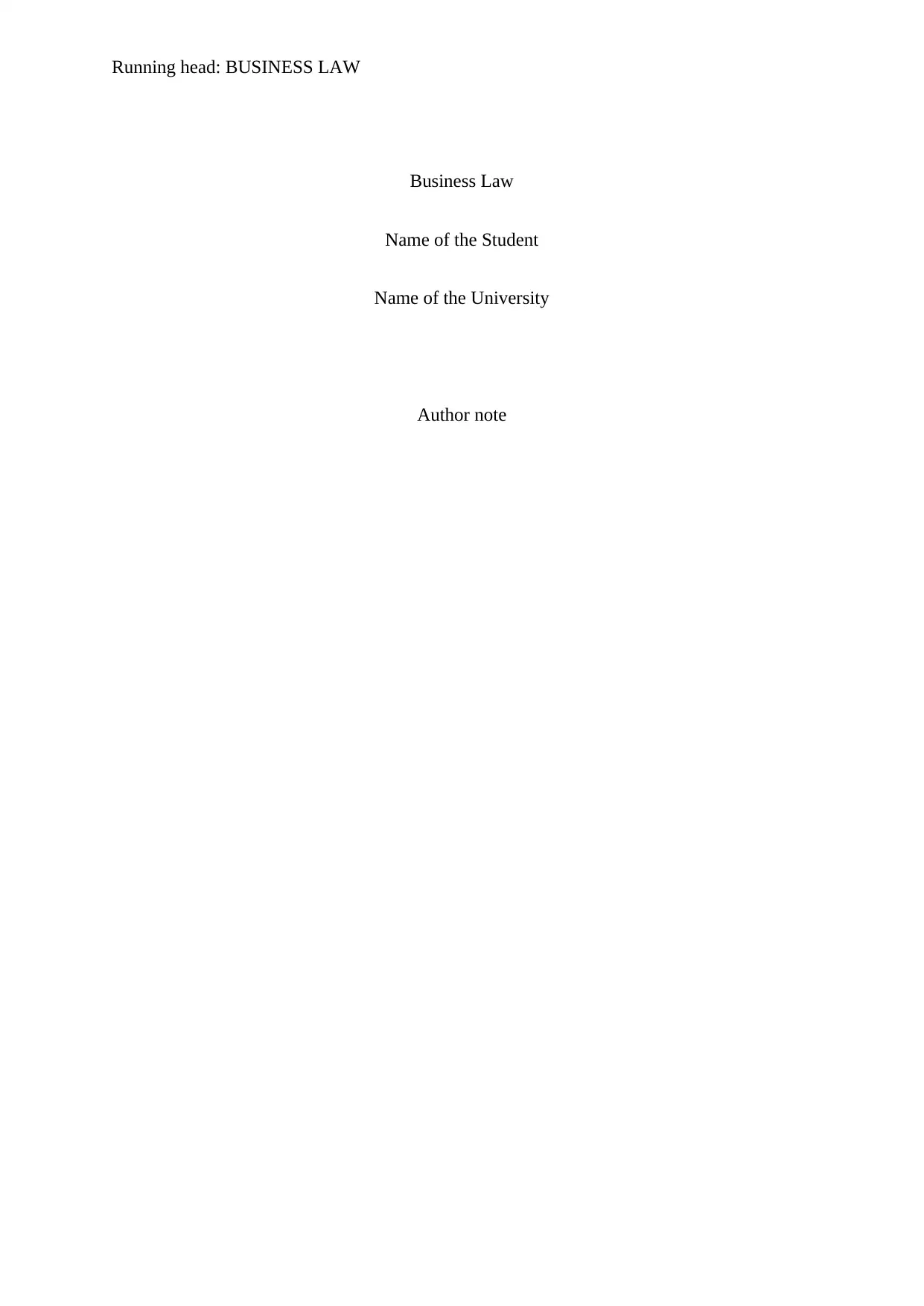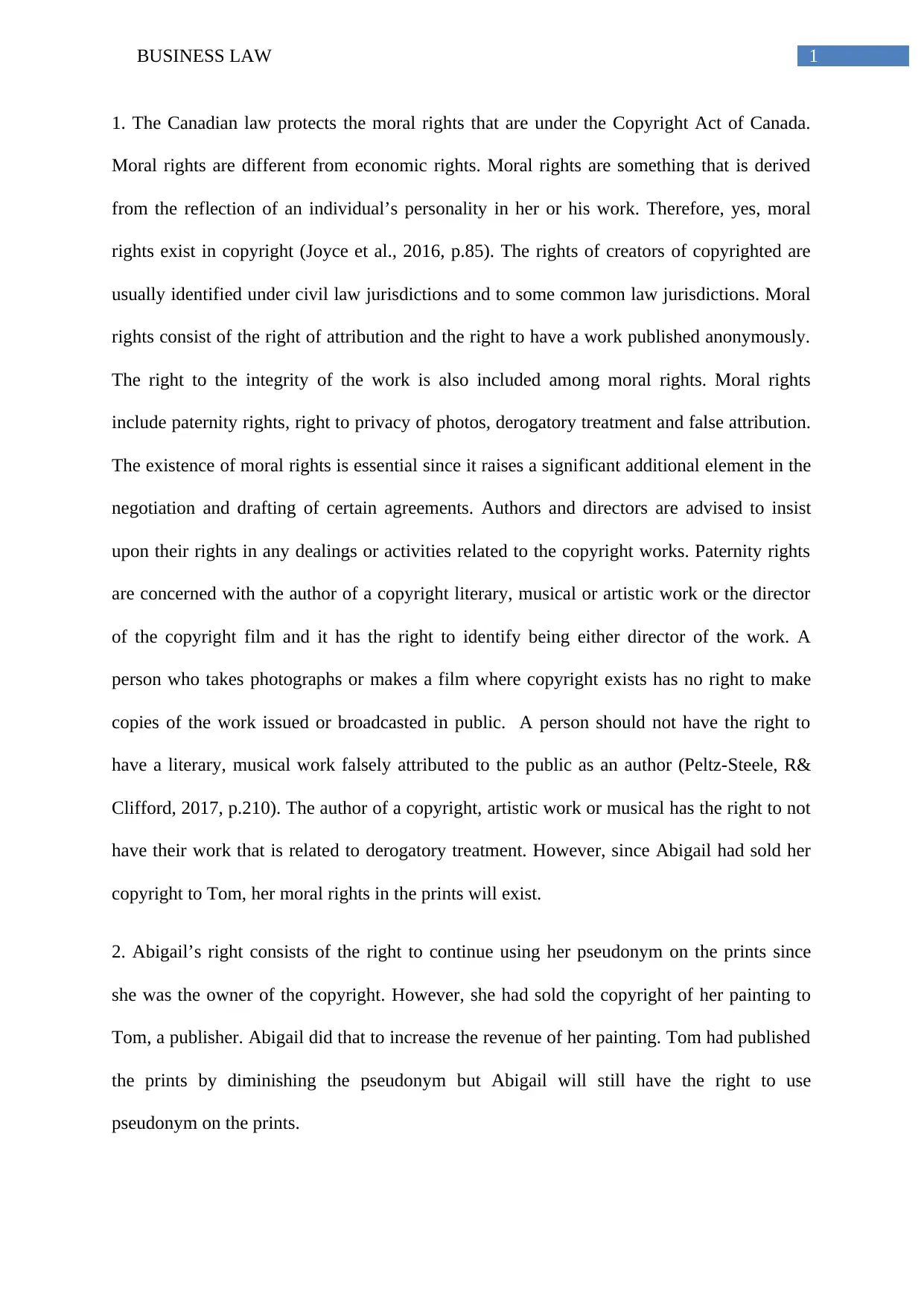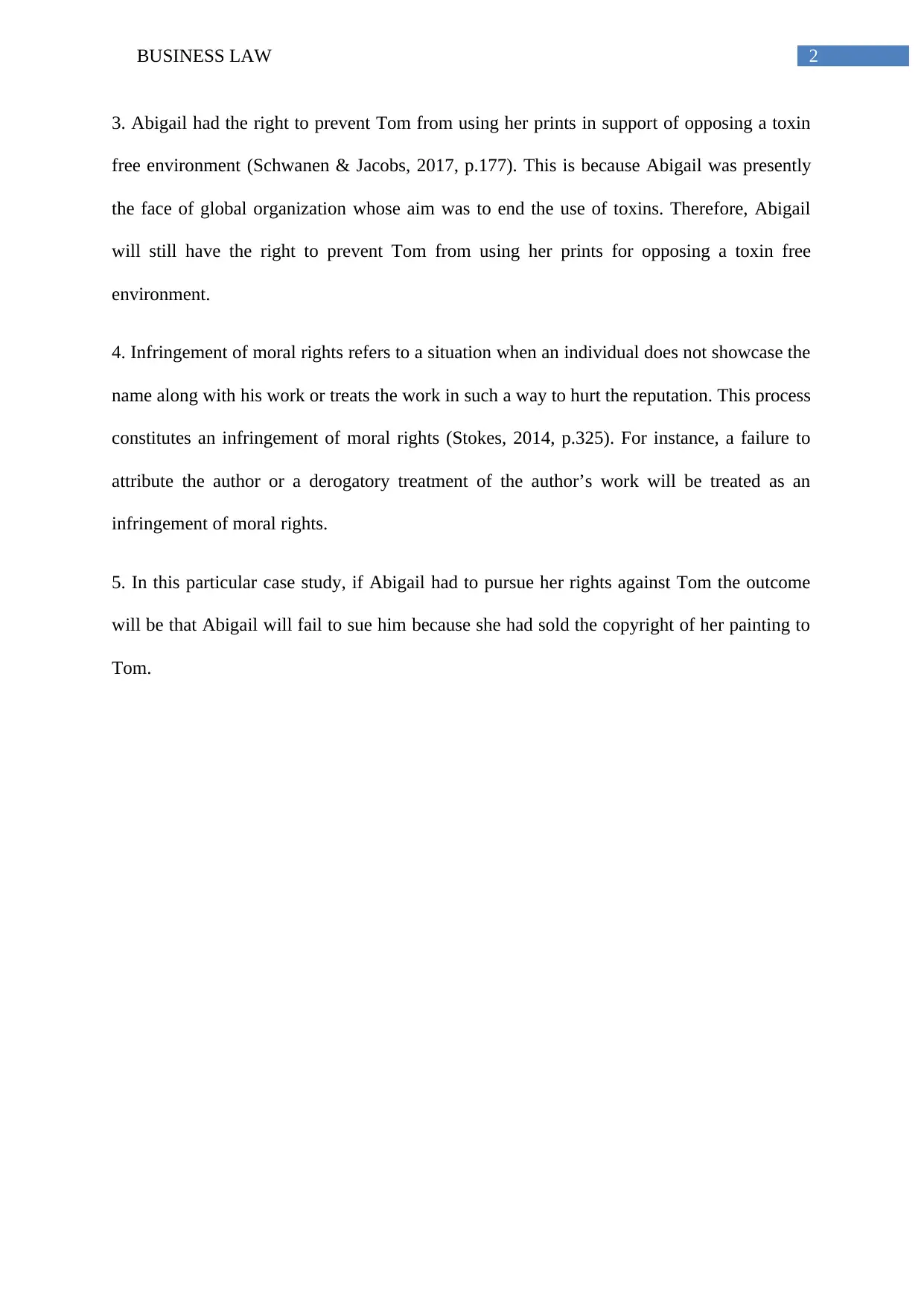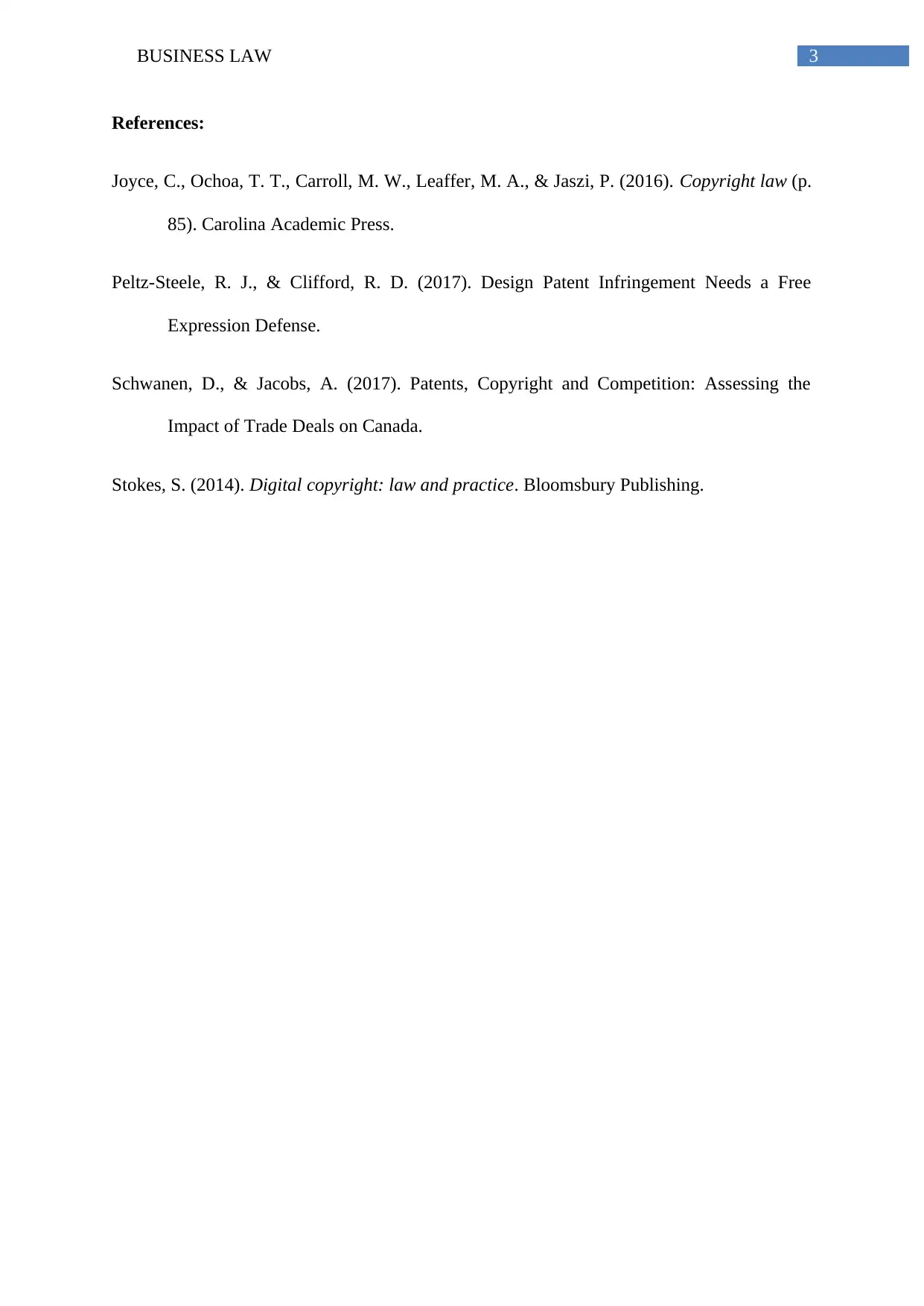Business Law Assignment: Moral Rights and Copyright Issues
VerifiedAdded on 2021/04/17
|4
|724
|62
Homework Assignment
AI Summary
This Business Law assignment addresses the concept of moral rights under the Copyright Act of Canada, differentiating them from economic rights. It explores the rights of creators, including attribution, anonymity, and integrity. The assignment analyzes a case study involving Abigail, who sold her copyright but retains certain moral rights. It examines Abigail's rights regarding pseudonym usage and preventing the use of her work in support of opposing views. The assignment defines the infringement of moral rights and concludes that Abigail would likely fail in a lawsuit against Tom due to the copyright sale. The solution references relevant legal sources and principles.

Running head: BUSINESS LAW
Business Law
Name of the Student
Name of the University
Author note
Business Law
Name of the Student
Name of the University
Author note
Paraphrase This Document
Need a fresh take? Get an instant paraphrase of this document with our AI Paraphraser

1BUSINESS LAW
1. The Canadian law protects the moral rights that are under the Copyright Act of Canada.
Moral rights are different from economic rights. Moral rights are something that is derived
from the reflection of an individual’s personality in her or his work. Therefore, yes, moral
rights exist in copyright (Joyce et al., 2016, p.85). The rights of creators of copyrighted are
usually identified under civil law jurisdictions and to some common law jurisdictions. Moral
rights consist of the right of attribution and the right to have a work published anonymously.
The right to the integrity of the work is also included among moral rights. Moral rights
include paternity rights, right to privacy of photos, derogatory treatment and false attribution.
The existence of moral rights is essential since it raises a significant additional element in the
negotiation and drafting of certain agreements. Authors and directors are advised to insist
upon their rights in any dealings or activities related to the copyright works. Paternity rights
are concerned with the author of a copyright literary, musical or artistic work or the director
of the copyright film and it has the right to identify being either director of the work. A
person who takes photographs or makes a film where copyright exists has no right to make
copies of the work issued or broadcasted in public. A person should not have the right to
have a literary, musical work falsely attributed to the public as an author (Peltz-Steele, R&
Clifford, 2017, p.210). The author of a copyright, artistic work or musical has the right to not
have their work that is related to derogatory treatment. However, since Abigail had sold her
copyright to Tom, her moral rights in the prints will exist.
2. Abigail’s right consists of the right to continue using her pseudonym on the prints since
she was the owner of the copyright. However, she had sold the copyright of her painting to
Tom, a publisher. Abigail did that to increase the revenue of her painting. Tom had published
the prints by diminishing the pseudonym but Abigail will still have the right to use
pseudonym on the prints.
1. The Canadian law protects the moral rights that are under the Copyright Act of Canada.
Moral rights are different from economic rights. Moral rights are something that is derived
from the reflection of an individual’s personality in her or his work. Therefore, yes, moral
rights exist in copyright (Joyce et al., 2016, p.85). The rights of creators of copyrighted are
usually identified under civil law jurisdictions and to some common law jurisdictions. Moral
rights consist of the right of attribution and the right to have a work published anonymously.
The right to the integrity of the work is also included among moral rights. Moral rights
include paternity rights, right to privacy of photos, derogatory treatment and false attribution.
The existence of moral rights is essential since it raises a significant additional element in the
negotiation and drafting of certain agreements. Authors and directors are advised to insist
upon their rights in any dealings or activities related to the copyright works. Paternity rights
are concerned with the author of a copyright literary, musical or artistic work or the director
of the copyright film and it has the right to identify being either director of the work. A
person who takes photographs or makes a film where copyright exists has no right to make
copies of the work issued or broadcasted in public. A person should not have the right to
have a literary, musical work falsely attributed to the public as an author (Peltz-Steele, R&
Clifford, 2017, p.210). The author of a copyright, artistic work or musical has the right to not
have their work that is related to derogatory treatment. However, since Abigail had sold her
copyright to Tom, her moral rights in the prints will exist.
2. Abigail’s right consists of the right to continue using her pseudonym on the prints since
she was the owner of the copyright. However, she had sold the copyright of her painting to
Tom, a publisher. Abigail did that to increase the revenue of her painting. Tom had published
the prints by diminishing the pseudonym but Abigail will still have the right to use
pseudonym on the prints.

2BUSINESS LAW
3. Abigail had the right to prevent Tom from using her prints in support of opposing a toxin
free environment (Schwanen & Jacobs, 2017, p.177). This is because Abigail was presently
the face of global organization whose aim was to end the use of toxins. Therefore, Abigail
will still have the right to prevent Tom from using her prints for opposing a toxin free
environment.
4. Infringement of moral rights refers to a situation when an individual does not showcase the
name along with his work or treats the work in such a way to hurt the reputation. This process
constitutes an infringement of moral rights (Stokes, 2014, p.325). For instance, a failure to
attribute the author or a derogatory treatment of the author’s work will be treated as an
infringement of moral rights.
5. In this particular case study, if Abigail had to pursue her rights against Tom the outcome
will be that Abigail will fail to sue him because she had sold the copyright of her painting to
Tom.
3. Abigail had the right to prevent Tom from using her prints in support of opposing a toxin
free environment (Schwanen & Jacobs, 2017, p.177). This is because Abigail was presently
the face of global organization whose aim was to end the use of toxins. Therefore, Abigail
will still have the right to prevent Tom from using her prints for opposing a toxin free
environment.
4. Infringement of moral rights refers to a situation when an individual does not showcase the
name along with his work or treats the work in such a way to hurt the reputation. This process
constitutes an infringement of moral rights (Stokes, 2014, p.325). For instance, a failure to
attribute the author or a derogatory treatment of the author’s work will be treated as an
infringement of moral rights.
5. In this particular case study, if Abigail had to pursue her rights against Tom the outcome
will be that Abigail will fail to sue him because she had sold the copyright of her painting to
Tom.
⊘ This is a preview!⊘
Do you want full access?
Subscribe today to unlock all pages.

Trusted by 1+ million students worldwide

3BUSINESS LAW
References:
Joyce, C., Ochoa, T. T., Carroll, M. W., Leaffer, M. A., & Jaszi, P. (2016). Copyright law (p.
85). Carolina Academic Press.
Peltz-Steele, R. J., & Clifford, R. D. (2017). Design Patent Infringement Needs a Free
Expression Defense.
Schwanen, D., & Jacobs, A. (2017). Patents, Copyright and Competition: Assessing the
Impact of Trade Deals on Canada.
Stokes, S. (2014). Digital copyright: law and practice. Bloomsbury Publishing.
References:
Joyce, C., Ochoa, T. T., Carroll, M. W., Leaffer, M. A., & Jaszi, P. (2016). Copyright law (p.
85). Carolina Academic Press.
Peltz-Steele, R. J., & Clifford, R. D. (2017). Design Patent Infringement Needs a Free
Expression Defense.
Schwanen, D., & Jacobs, A. (2017). Patents, Copyright and Competition: Assessing the
Impact of Trade Deals on Canada.
Stokes, S. (2014). Digital copyright: law and practice. Bloomsbury Publishing.
1 out of 4
Related Documents
Your All-in-One AI-Powered Toolkit for Academic Success.
+13062052269
info@desklib.com
Available 24*7 on WhatsApp / Email
![[object Object]](/_next/static/media/star-bottom.7253800d.svg)
Unlock your academic potential
Copyright © 2020–2025 A2Z Services. All Rights Reserved. Developed and managed by ZUCOL.





